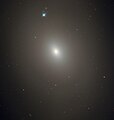Vaizdas:Messier85 - HST - Potw1905a.jpg

Šios peržiūros dydis: 567 × 599 taškų. Kitos 6 rezoliucijos: 227 × 240 taškų | 454 × 480 taškų | 727 × 768 taškų | 969 × 1 024 taškų | 1 938 × 2 048 taškų | 3 860 × 4 079 taškų.
Didesnės raiškos iliustracija (3 860 × 4 079 taškų, rinkmenos dydis: 2,97 MiB, MIME tipas: image/jpeg)
Rinkmenos istorija
Paspauskite ant datos/laiko, kad pamatytumėte rinkmeną tokią, kokia ji buvo tuo metu.
| Data/Laikas | Miniatiūra | Matmenys | Naudotojas | Paaiškinimas | |
|---|---|---|---|---|---|
| dabartinis | 11:45, 4 vasario 2019 |  | 3 860 × 4 079 (2,97 MiB) | Fabian RRRR | == {{int:filedesc}} == {{Information |Description='''The darkness within? This atmospheric image shows a galaxy named Messier 85, captured in all its delicate, hazy glory by the NASA/ESA Hubble Space Telescope. Messier 85 slants through the constellation of Coma Berenices (Berenice’s Hair), and lies around 50 million light-years from Earth. It was first discovered by Charles Messier’s colleague Pierre Méchain in 1781, and is included in the Messier catalogue of celestial objects. Messier 8... |
Paveikslėlio naudojimas
Paveikslėlis yra naudojamas šiuose puslapiuose:
Visuotinis rinkmenos naudojimas
Ši rinkmena naudojama šiose viki svetainėse:
- Naudojama ar.wikipedia.org
- Naudojama de.wikipedia.org
- Naudojama en.wikipedia.org
- Naudojama fr.wikipedia.org
- Naudojama hu.wikipedia.org
- Naudojama it.wikipedia.org
- Naudojama ja.wikipedia.org
- Naudojama mk.wikipedia.org
- Naudojama pl.wikipedia.org
- Naudojama ru.wikipedia.org
- Naudojama sv.wikipedia.org



